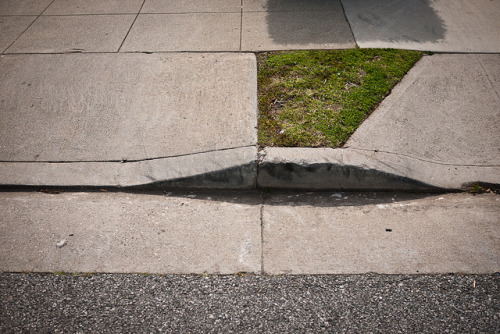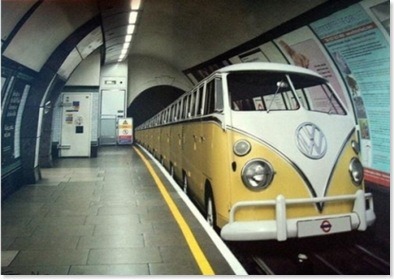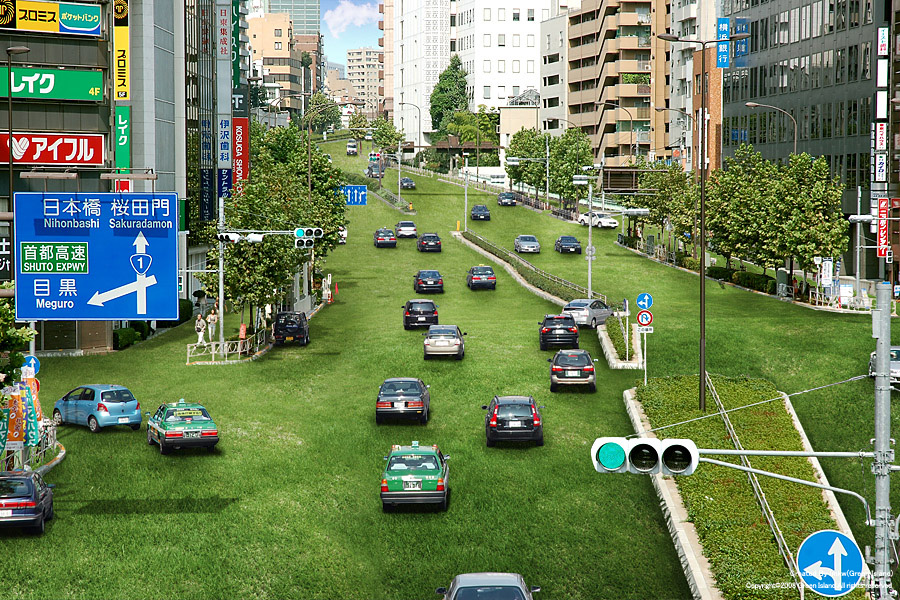

My wife, who grew up near the sleepy beach towns of Jamaica, asks me every time we drive along PCH: who decided to put a freeway next to the ocean? Blemishing the very thing that makes California so famous? We Angelenos have grown used to the mayhem that happens along this famously fast stretch of road, and not just certain Ferrari Enzos sliced in half by crazed millionaires and careening jaunts by drunk neo-Nazi celebrities — crashes on PCH are a regular part of our morning commute. The road is another classic example of the Angelene Paradox: almost daily violence and road rage, but in an idyllic setting. Part of me wishes we could do a better job of living up to our laid-back reputation, but I know better. Hawaii has its traffic jams, for instance. Crime happens in the Bahamas. No place perfectly aligns with its ideal image. But couldn't we, you know, maybe try a little? See it narrowed!




 Amazing quote from the Head Traffic Engineer in Denton, Texas that pretty much sums up the infrastructural corner we've painted ourselves into. Behind all the technical smoke-and-mirror excuses lies a simple unwillingness to question the wisdom of initial urban design mistakes made long ago.
Amazing quote from the Head Traffic Engineer in Denton, Texas that pretty much sums up the infrastructural corner we've painted ourselves into. Behind all the technical smoke-and-mirror excuses lies a simple unwillingness to question the wisdom of initial urban design mistakes made long ago. Sorry about the lack of posts lately--I had some writing deadlines to take care of, which sucked away all my time. But if you wanna catch up, meet me in Echo Park where I'll be showing Narrow Streets photos in a group art exhibit. Woo hoo!
Sorry about the lack of posts lately--I had some writing deadlines to take care of, which sucked away all my time. But if you wanna catch up, meet me in Echo Park where I'll be showing Narrow Streets photos in a group art exhibit. Woo hoo! 
 I'm endlessly fascinated by Downtown LA. It teems with life during the weekday; at night and on weekends, it becomes a zombie-filled ghost town worthy of a level design from Left 4 Dead. It is crowded with buildings but at the same time overbuilt for cars — a paradox that leaves it neither here (is it a city?) or there (is it a suburb?). The photo above shows what Angelenos would consider a "small" street at only five cars wide. A similarly-sized street in New York City, by contrast, would be considered a major conduit. 8th Ave, for instance, is as wide as the street above because it borders crowd magnets like Madison Square Garden and Penn Station — makes sense, right? But that's New York City, which has a variety of street sizes befitting local use: one-lane roads for residential neighborhoods, and larger arteries for heavily trafficked areas. In Los Angeles, on the other hand, every street behaves as if it were a regional conduit regardless of actual, boots-on-the-ground use. The city becomes merely a place to pass through, not a destination unto itself, leaving only the roar of traffic and the crazed bellowing of its down-and-out street denizens echoing off its walls.
I'm endlessly fascinated by Downtown LA. It teems with life during the weekday; at night and on weekends, it becomes a zombie-filled ghost town worthy of a level design from Left 4 Dead. It is crowded with buildings but at the same time overbuilt for cars — a paradox that leaves it neither here (is it a city?) or there (is it a suburb?). The photo above shows what Angelenos would consider a "small" street at only five cars wide. A similarly-sized street in New York City, by contrast, would be considered a major conduit. 8th Ave, for instance, is as wide as the street above because it borders crowd magnets like Madison Square Garden and Penn Station — makes sense, right? But that's New York City, which has a variety of street sizes befitting local use: one-lane roads for residential neighborhoods, and larger arteries for heavily trafficked areas. In Los Angeles, on the other hand, every street behaves as if it were a regional conduit regardless of actual, boots-on-the-ground use. The city becomes merely a place to pass through, not a destination unto itself, leaving only the roar of traffic and the crazed bellowing of its down-and-out street denizens echoing off its walls. 




 I like to think of Wilshire Corridor as LA's own sort of Upper East Side Park Avenue, with its long stretch of luxury condo high-rises catering to the older wealthy. I can even imagine Eloise traipsing along, au pair in pursuit, on her way from Westwood to Beverly Hills. But as with all things Los Angeles, this east coast facsimile has a unique west coast twist: eight lanes of heart-pumping traffic careening up and down its hilly curves at a blistering 55mph. (Try it on a 125cc scooter, and it's even more hair-raising.) The usual paradox is there: heavenly towers with names promising old world grandeur ("The Wilshire Marquis", or the more pastoral "Carlyle on Wilshire") located right alongside what is practically a freeway. Me + the wife looked here once for an apartment, and could not get past the constant echo of traffic, double-paned windows be damned.
I like to think of Wilshire Corridor as LA's own sort of Upper East Side Park Avenue, with its long stretch of luxury condo high-rises catering to the older wealthy. I can even imagine Eloise traipsing along, au pair in pursuit, on her way from Westwood to Beverly Hills. But as with all things Los Angeles, this east coast facsimile has a unique west coast twist: eight lanes of heart-pumping traffic careening up and down its hilly curves at a blistering 55mph. (Try it on a 125cc scooter, and it's even more hair-raising.) The usual paradox is there: heavenly towers with names promising old world grandeur ("The Wilshire Marquis", or the more pastoral "Carlyle on Wilshire") located right alongside what is practically a freeway. Me + the wife looked here once for an apartment, and could not get past the constant echo of traffic, double-paned windows be damned. 




 Reader Severin Martinez sent in a snapshot of the Berkeley campus (my alma mater...go Bears!) near the Campanile.
Reader Severin Martinez sent in a snapshot of the Berkeley campus (my alma mater...go Bears!) near the Campanile. 

 Via
Via 




 From
From 
 Here's the intersection right around the corner from my house. The office towers proudly call themselves the "Gateway" to "Westwood," but I think of it as the point where the great
Here's the intersection right around the corner from my house. The office towers proudly call themselves the "Gateway" to "Westwood," but I think of it as the point where the great 
 When I used to live in Santa Monica I would walk one mile to work each way, a lovely commute that seems enviable now. I tended to avoid busier streets like Montana, Washington (which has become an overcrowded, illusory "shortcut" to nearby Wilshire), and the "3n+2" streets: 11th, 14th, and 17th, all of which have signal lights and therefore invite faster traffic.
When I used to live in Santa Monica I would walk one mile to work each way, a lovely commute that seems enviable now. I tended to avoid busier streets like Montana, Washington (which has become an overcrowded, illusory "shortcut" to nearby Wilshire), and the "3n+2" streets: 11th, 14th, and 17th, all of which have signal lights and therefore invite faster traffic.  A classic Volkswagen Microbus, put to much better use. Thanks to reader
A classic Volkswagen Microbus, put to much better use. Thanks to reader 















